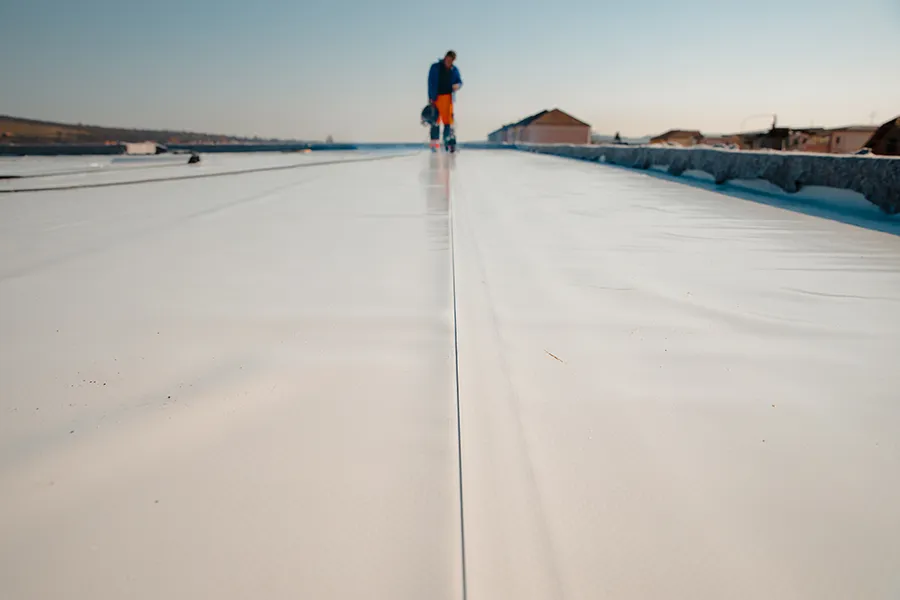When you hear “flat roof,” you probably think of endless leaks and headaches. You’re not alone—but you deserve the truth. Flat roofs aren’t doomed, and with a few smart habits, yours can last longer than you’d expect. Living in St. Catharines or the Niagara area means dealing with sudden storms, lake-effect wind, and brutal freeze-thaw cycles, so your maintenance plan matters even more.
Myth: “Flat roofs always leak”
This one probably came from a neighbor or family member. The reality? Flat roofs don’t fail because they’re flat—they fail because water, time, and neglect win. You can stack the odds in your favor with timely repairs and simple inspections.
Start by checking the usual suspects: seams, edges, and penetrations. Give skylights, vents, and HVAC curbs a careful look. Treat flashing like the star of the show—good flashing keeps water where it belongs, while neglected flashing invites disaster. When you spot blistering or lifting seams, act quickly. AJT Roofing & Contracting offers 24/7 emergency support across the region, which helps when water doesn’t wait.
Myth: “Ponding water is no big deal”
Those shallow puddles after rain? They’re shortening your membrane’s life, stressing seams, and growing algae. Fix drainage first—clear drains and scuppers, make sure strainers are clean, and consider tapered insulation where slopes need help. For a simple, research-based checklist, see the National Research Council guide to flat-roof inspection and maintenance.
Watch for depressions around heavy equipment and service paths. Foot traffic can bruise a membrane, so add walkway pads and set gentle rules for rooftop access. If depressions spread or wet insulation keeps returning, it’s time to compare repair costs with full replacement.
Myth: “Any coating will fix everything”
Coatings can be fantastic when used correctly, but they’re not a cure for structural problems or open seams. Match the coating to your membrane—EPDM, TPO, PVC, or BUR all have different requirements. Fix blisters and open seams before coating, and replace wet insulation instead of sealing it in.
When a membrane is brittle or near the end of its rated life, repairs may only buy you a short time. In that case, a well-planned replacement can stabilize costs and reduce surprise leaks during Niagara’s heavier weather.
Myth: “EPDM, TPO, and PVC are basically the same”
Your wallet disagrees. EPDM is flexible and cold-friendly, TPO is popular for reflectivity and heat-welded seams, while PVC handles grease and chemicals better. Choose based on building use, climate, and budget—not buzzwords.
Watch for plasticizer loss on older PVC, seam fatigue on aging TPO, and shrinkage at EPDM edges. Use the right primers and patch kits every time. When patches start multiplying, step back and run a real cost comparison between repair and replacement.
Myth: “DIY saves more than pros ever will”
You can handle smart DIY tasks—clearing drains, photographing issues, applying temporary patches in safe conditions. But don’t attempt hot-work, heat-welding, or full re-roofing alone. Respect gravity, wind, and slick membranes. When work exceeds your comfort level, call in professionals. AJT emphasizes in-house crews with guaranteed workmanship and lifetime materials guarantees through their manufacturer partners.
Reality: Maintenance beats emergencies
Schedule two checkups each year—spring and autumn—plus extra checks after big storms. Keep a simple roof log with dates and photos. Catch a lifted seam before the wind finds it. Resecure a loose drain clamp before debris builds. Reseal a cracked penetration boot before rain returns. These quick moves prevent expensive failures and help you delay replacement until it makes financial sense.
Reality: Smart upgrades extend roof life
Add tapered insulation where ponding is stubborn. Install overflow scuppers to limit standing water. Place walkway pads around service paths and rooftop units. Upgrade to better boots at pipe penetrations and replace brittle pitch pans with modern details. Choose light-colored membranes where heat is brutal.
Compare repair budgets against replacement cycles and factor in potential energy savings from reflective surfaces. AJT lists certifications and partnerships with recognized manufacturers, plus recent local awards—signals of stable support and vetted product lines.
Reality: A plan keeps you calm and dry
Write a one-page plan listing your membrane type, install year, warranty details, safe access notes, and your roofer’s emergency number. Sketch drain and equipment locations, then keep it with your roof log. Handle today’s problems with measured repairs, and choose replacement only when the numbers say so. You don’t need magic—just habits and patience.
Frequently Asked Questions (FAQs)
1. Do flat roofs inherently leak more often than pitched roofs?
Reality: No. Flat roofs do not fail simply because they are flat; they fail primarily because of neglect, time, and water intrusion from unaddressed damage. The key factors leading to leaks are typically compromised areas such as seams, edges, and penetrations (like skylights or vents) where flashing has deteriorated or was improperly installed. With timely repairs and regular, simple inspections, a flat roof can meet or exceed life expectancy.
2. Is ponding water on a flat roof acceptable, and how should I fix it?
Reality: No, ponding water (water that remains 48 hours after precipitation) is not acceptable. It significantly shortens the life of the membrane, stresses seams, and promotes the growth of algae. To fix it, you must improve the drainage system. This involves:
Clearing drains and scuppers.
Ensuring strainers are clean.
Considering the installation of tapered insulation to create a positive slope and guide water toward the drains.
3. Can I use any protective coating to quickly fix a leaking flat roof?
Reality: Coatings can be a great restorative tool, but they are not a cure-all. You must match the coating material to the specific underlying membrane (e.g., EPDM, TPO, PVC, or BUR). Coatings will not fix structural problems or open seams. For a successful repair, you must first fix blisters and open seams, and replace any wet insulation before a coating is applied.
4. What is the fundamental difference between EPDM, TPO, and PVC flat roofing membranes?
Reality: These are distinct materials chosen for different applications, climates, and budgets:
EPDM (Ethylene Propylene Diene Monomer): Highly flexible and performs well in colder climates.
TPO (Thermoplastic Polyolefin): Popular for its reflectivity, energy efficiency, and durable heat-welded seams.
PVC (Polyvinyl Chloride): Offers the highest resistance to grease, chemicals, and foot traffic, making it ideal for restaurants or industrial buildings.
5. What are the most important maintenance steps for extending a flat roof’s life?
Reality: Consistent, preventative maintenance is more cost-effective than emergency repairs. The most important steps are:
Scheduled Inspections: Perform a checkup every spring and autumn, plus extra checks after major storms.
Clear Drainage: Ensure all drains, scuppers, and strainers are completely clear of debris.
Address Penetrations: Immediately reseal cracked penetration boots and resecure loose drain clamps.
Limit Traffic: Implement gentle rules for rooftop access and install walkway pads around frequently serviced equipment (like HVAC units) to protect the membrane.
Relevant Government Resources
These official resources pertain to roofing standards, building codes, and worker safety, which are critical elements of flat roof repair and construction.
Occupational Safety and Health Administration (OSHA) Fall Protection Standards (U.S. Department of Labor)
Relevance: Directly addresses the article’s point about DIY risks by providing mandatory safety guidelines for working at heights. OSHA regulations (specifically 29 CFR 1926) define the use of guardrails, safety nets, personal fall arrest systems, and warning lines required for professional roofing work on low-slope roofs.
Resource Example: Protecting Roofing Workers (OSHA Publication)
National Building Code of Canada (NBC) / Canadian General Standards Board (CGSB)
Relevance: The NBC serves as a foundational model code (adopted by provinces/territories) that outlines the minimum acceptable measures for safety and structural protection, which includes strict requirements for roof design. The NBC dictates standards for materials (like CGSB-37.54 for PVC membranes) and defines “platforms that effectively serve as roofs” that must meet proper drainage requirements.
Resource Example: National Research Council of Canada (NRC) Publications on the National Building Code (searchable via the NRC’s website).
Cool Roof Rating Council (CRRC) Codes, Programs & Standards (Supported by U.S. Federal/State Energy Initiatives)
Relevance: This non-governmental body provides objective ratings for solar reflectance and thermal emittance, which are incorporated into many state and local energy codes (like the International Energy Conservation Code—IECC). It supports the article’s point about “smart upgrades” by helping contractors and property owners choose reflective “cool roof” materials (like white TPO or coatings) to improve energy efficiency in low-slope roof systems.
Resource Example: Cool Roof Rating Council Codes & Standards Reference



